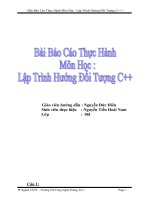Slide thuyet trinh Lap trinh nhung,hương doi tượng
Bạn đang xem bản rút gọn của tài liệu. Xem và tải ngay bản đầy đủ của tài liệu tại đây (1.64 MB, 19 trang )
Mapping EER Model Constructs to
Relations
Option 8C: Single relation with one type attribute
Create a single relation L with attributes Attrs(L) = {k,a1,…an} U {attributes of S1}
U…U {attributes of Sm} U {t} and PK(L) = k. The attribute t is called a type (or
discriminating) attribute that indicates the subclass to which each tuple belongs
Option 8D: Single relation with multiple type attributes
Create a single relation schema L with attributes Attrs(L) = {k,a1,…an} U {attributes
of S1} U…U {attributes of Sm} U {t1, t2,…,tm} and PK(L) = k. Each ti , 1 < I < m, is a
Boolean type attribute indicating whether a tuple belongs to the subclass Si
Mapping EER Model Constructs to
Relations
Mapping of Shared Subclasses (Multiple Inheritance)
A shared subclass, such as STUDENT_ASSISTANT, is a subclass of several
classes, indicating multiple inheritance. These classes must all have the same
key attribute; otherwise, the shared subclass would be modeled as a category.
We can apply any of the options discussed in Step 8 to a shared subclass,
subject to the restriction discussed in Step 8 of the mapping algorithm. Below
both 8C and 8D are used for the shared class STUDENT_ASSISTANT.
Y sĩ
Mã số
Tên
N.Sinh
Địa chỉ
C.Ngành
Y tá
Mã số
Tên
N.Sinh
Địa chỉ
Mã CCTN
Mã số
Tên
N.Sinh
Địa chỉ
Mã số
Tên
N.Sinh
Địa chỉ
KTV
NV V.Phòng
SĐT
Mã số NV
SĐT
Kỹ năng
Mã số NV
Kỹ năng
Loại CV
Y sĩ
Mã số
Bệnh nhân Mã số
Tên
N.Sinh
Địa chỉ
NNV
Địa chỉ
Mã y sĩ
C.Ngành
CSVC
Khu Điều trị
P Thí Nghiệm
Mã số
Mã số
Mã số
Địa điểm
Tên
Mapping EER Model Constructs to
Relations
Step 9: Mapping of Union Types (Categories).
For mapping a category whose defining superclass have different keys, it is
customary to specify a new key attribute, called a surrogate key, when
creating a relation to correspond to the category.
In the example below we can create a relation OWNER to correspond to the
OWNER category and include any attributes of the category in this relation.
The primary key of the OWNER relation is the surrogate key, which we called
OwnerId.
Exercise 4
Airplane
Service
Reg#
Date
Workcode
Reg#
Hours
Corporation
Name
Address
Person
Ssn
Owner
OwnerID
Name
Phone
Address
OwnerID
Phone
OwnerID
Employee
Ssn
Salary
Shif
Pilot
Ssn
Restr
Lic_num
Person
Ssn
Name
Address
Phone
OwnerID
Plane_Type
Employee
Work_on
Model
Ssn
Capacity
Salary
Model
Ssn
Shif
Weight
Plane_Type
Model
Pilot
Ssn
File
Model
Capacity
Restr
Ssn
Weight
Lic_num
Employee
Ssn
Salary
Shif
Service
Date
Workcode
Reg#
Hours
Maintain
Date
Workcode
Reg#
Ssn
Owner
Air_Plane
Owns
OwnerID
Reg#
OwnerID
Reg#
Pdate









